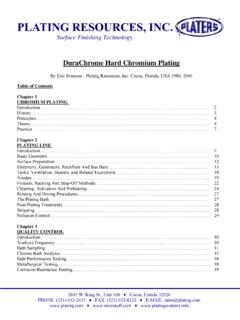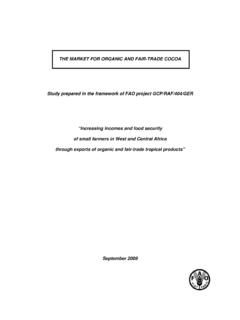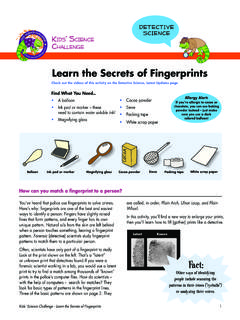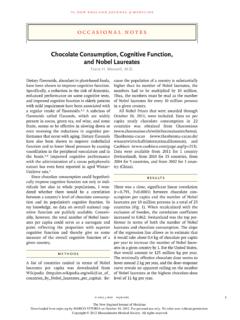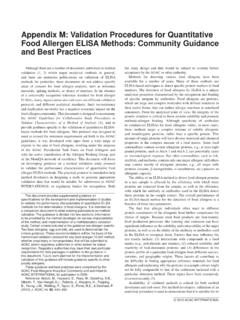Transcription of Hard Chrome Study - Plating
1 hard Chrome Study By Plating Resources, Inc. 2845 West King St. Unit 108 cocoa , Florida, 32926, USA Covering Some Overlooked Technology. This Information Can Significantly Reduce Your Plating Costs. This Helps hard Chrome Shops By: Becoming More Competitive. Providing Faster Services. Lowering Electrical Costs. Improving Work Efficiency. First, a story from Mr. Stephen Covey, the author of The 7 Habits Of Highly Effective People. A man is trying to cut down a tree with a very dull saw. His curious neighbor asked him why he didn t sharpen the saw to speed up the process and ease his burden. The man replies, Can t you see that I m too busy cutting down this tree to stop and sharpen the saw? Many of us continue doing things the same old way. We do so knowing there must be a better way that would save us time, money and aggravation.
2 Yet, we sometimes develop tunnel vision and hang on to the old worn-out ways because we don t take the time to learn how to do things better, faster and more efficiently. This paper addresses a similar situation in the hard Chrome Plating industry. This technology can save you vast amounts of aggravation while also drastically lowering your costs and increasing your shops efficiency. 8 pages Chrome Bath Purification Methods Plating Resources, Inc. 2845 West King St. Unit 108 cocoa , Florida, 32926, USA 2007 Actually we are relearning some old technology here. Years ago, hard Chrome shops knew the value of keeping their baths clean and free of impurities.
3 Their simple approach was to dilute & replace a portion of their baths whenever needed to reduce their impurity levels. They could tell by simple observation of the mist color when this was needed. This was before convenient laboratory services were available that could pinpoint exact impurity levels. All of that changed around 1970 with the EPA and the high cost of hazardous disposal. Plating shops could no longer afford the cost of hauling their waste away. Busy work schedules caused us to overlook the benefits of keeping the Chrome bath clean. Over the years, impurities like trivalent, iron and copper gradually built-up in the baths. This resulted in much higher Plating costs and a reduction in deposit quality. Most Plating shops have since accepted this as the norm and the way things are supposed to be.
4 Several forward looking shops, however, purchased bath purification equipment. But is this equipment really practical and is it cost effective? The simple answer is no, as most have not lived up to their claims and the operational costs are very high. Now is the time to revisit this subject as disposal costs are now much lower. Here we will look at the pros & cons of various purification techniques and present a detailed cost Study of these. The final result is shocking. This project was started when a Venezuelan company built a new plant to manufacture and Chrome plate large quantities of positive displacement pump rotors. The company was concerned about maintaining their baths in a pure state to keep their costs down and preserve their deposit quality. We started this project by investigating the latest technology in bath purification methods.
5 The two most prominent ones seemed to be: 1) Ion Exchange 2) Membrane Electrolysis But, we had no firm ideas of the cost involved with buying, operating and maintaining these systems. Several purification equipment manufacturers were interviewed and from this we were able to come to some conclusions and provide a recommendation and cost options for the company and the industry. It turns out that the old school dilution & remaking is by far the best approach. Today, this is even less expensive than keeping an old impure bath is. Why? It s because the operational costs involved with Plating in a bath loaded with trivalent & metals is so high combined with today s much lower disposal costs. Objective Our objective is to review various bath purification technologies, their related costs, and to learn the actual cost of operating baths with high levels of impurities.
6 Maintaining Chrome Plating baths at low impurity levels is critical if high quality deposits and an efficient operation are desired. Keeping the Plating bath pure also reduces defects such as pitting and significantly lowers the electrical energy requirements. Some of the problems that high impurity levels cause include: Quality Related Deposit Pitting. Burning & Roughness. Dull Deposits. Trees and Nodules. Poor Coverage (Throw) & Skip- Plating . Blistering & Peeling. Deposit Stress & Brittleness. Softer Deposits. Reduced Wear Resistance. Macro-Cracking. Poor Corrosion Resistance. Limiting the Available Rectifier Current. Business Related Slower Plating Speeds. Excessive Stripping & Re-Work. Lower Production Rates. Higher Electrical Costs. Typical Impurities The goal is to maintain Chrome Plating baths in as pure a state as possible.
7 Any ion not intentionally included in the bath is considered an impurity, but the most common ones are chloride, trivalent, iron, copper and other heavy metals. The primary impurities include: Trivalent & Chloride The ideal trivalent level is 1% of the chromic acid in the bath, or about oz/gal ( g/l) for most baths. Anything above 1% is considered an impurity. Levels of 4-5%, or more, are considered extreme. Trivalent complexes the chromic acid by a factor of about oz/gal. for each percent present. This upsets the proper sulfate ratio. Example: A 30 oz/gal. bath with 5% trivalent has a usable Chrome level of only 18 oz/gal, so the effective ratio is reduced from 100:1 to only 60:1. Excess trivalent has about 6 times the negative effect that iron does. High trivalent levels also reduces the tolerance to other impurities.
8 Excess Trivalent is formed whenever the anode area is smaller than the cathode as in ID Plating , with poor anode electrical contact, when using heavily scaled (or yellow) lead alloy anodes, when using steel anodes, with excessive reverse etching and whenever metals like steel or copper are dissolved, or where organics such as oils are introduced into the bath. The ideal chloride (Cl) level is below 20 ppm, with 50 ppm or more considered excessive. Chloride acts as an extremely powerful catalyst which upsets the sulfate ratio. A level of 100 ppm has the effect of an additional oz/gal. of sulfate. The most common chloride source is drag-in from a hydrochloric acid stripper. Other sources can include the water supply, breakdown of PVC tank linings and piping, and impure chromic acid. DI water systems are recommended to eliminate excess chloride in the water supply.
9 Precipitation of chloride with silver compounds, while effective, is cost prohibitive. Fortunately, both trivalent and chloride are fairly easy and inexpensive to remove by simple dummying. Dummying converts the trivalent back into chromic acid and drives off chlorides at the anode surface. CR-r Reducer helps to remove these impurities when dummying. Use as large an anode area as possible (a 30:1 ratio is best but hard to achieve), along with a high bath temperature and current. Under these conditions the removal rate is 2% trivalent and 50 ppm of chloride per 24 hours; double these times for a 15:1 ratio. Longer times will be needed for lower ratios, temperatures or current settings. Also, lower impurity levels are reduced slower than higher levels are. So, while reducing the trivalent from 5% to 3% may only take 24 hours, going from 3% to 1% will take longer.
10 Shops with a constant trivalent (or chloride) problem should continuously operate a separate dummying tank. Porous pots are also effective for use in smaller tanks where the space is available. Regardless of the method, the addition of 1-2% of CR-3 Reducer helps greatly in removing both trivalent and chloride. Iron, Copper & other Heavy Metals The total heavy metals level (iron, copper nickel, etc.) should be kept below 5 g/l (combined) for most operations. In critical applications these should be below 1-2 g/l. Combined metal impurity levels of 8 g/l, or more, are considered extreme. Contrary to older beliefs, these metals do not plate out so they only continue to build up in the bath. And, as these metals are introduced into the bath, they also increase the trivalent level by an equal amount. Like trivalent, these metals combine with the chromic acid present to form an ionized complex that has the effect of lowering the effective sulfate ratio.
